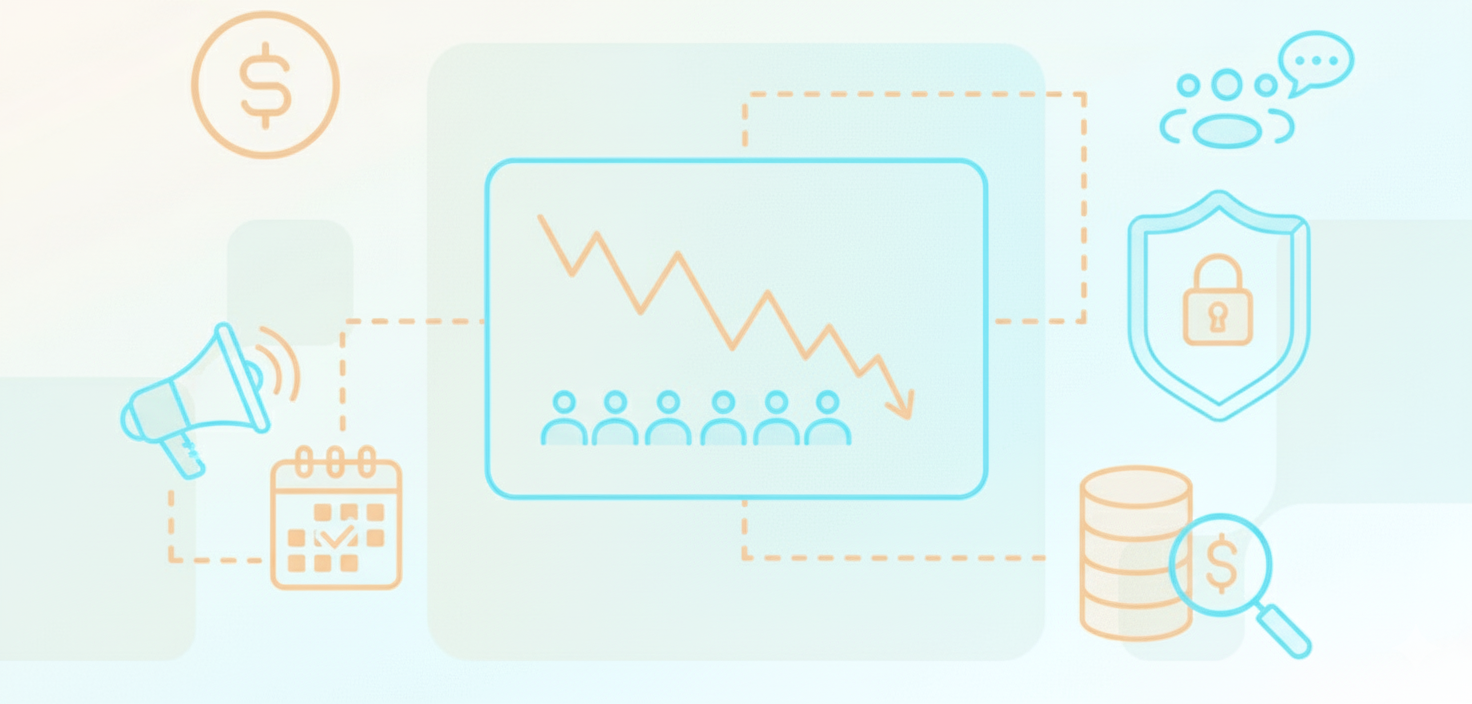顧客維持
SaaSチャーンマネジメントとは何ですか?

SaaSチャーンマネジメントとは何ですか?
SaaSチャーンマネジメントとは、SaaS企業が、サブスクリプションを解約または離脱する顧客の数を減らすために用いる、特定の戦略や施策のことです。
これには、解約の理由を特定し、それを防止するための措置を講じ、効果的な顧客維持戦略を実施することが含まれます。
チャーン管理の主な目的は、離脱する顧客数を減らすことで顧客生涯価値(CLV)を高めることにあり、それに合致する Qualaroo’の 顧客ニーズの理解を重視する点。
SaaS企業はチャーンをどのように定義すべきですか?
SaaSにおいて、チャーンとは顧客が企業のサービスを離れる行為を指します。しかし、この概念は複数の視点から捉えられるべきです。
- 顧客チャーン率とは、特定の期間内に離脱した顧客の数です。
- 収益チャーン率とは、顧客の離脱が総収益に与える影響に基づいて算出され、チャーンが財務に及ぼす影響の全体像を示します。
- グロスチャーンとは、解約やダウングレードによって失われた総収益のことです。
- ネットチャーンには、アップグレードやサービス拡大によって得られた収益が含まれます。
SaaSビジネスの健全性を評価する際には、グロスチャーン率とネットチャーン率の両方を考慮することが重要です。グロスチャーン率が高い場合でも、ネットチャーンにおいては高いアップセルによって相殺される可能性があるためです。
SaaSビジネスにとって、良好なチャーンレートとは何ですか?
SaaSにおける「良い」チャーン率は、通常、年間3%から5%の範囲に収まります。しかし、これは以下のいくつかの要因によって変動する可能性があります。
- 企業の規模
- 業界
- 料金モデル
- 顧客の種類(B2BまたはB2C)
- 契約期間
スタートアップ企業では、製品や市場発見の初期段階でチャーンレートが高くなる傾向があり、企業が成熟するにつれて減少する傾向にあります。
高いチャーンの発生は、製品、顧客サービス、または料金体系に関連する根本的な課題を反映している可能性があり、特にSaaSの文脈では頻繁なモニタリングが推奨されます。
SaaSチャーンマネジメントにおける一般的な課題は何ですか?
SaaSチャーンマネジメントの課題には以下があります:
- チャーンの兆候を認識すること
- 製品に対するネガティブな経験
- 顧客獲得コスト(CAC)への過剰な投資
- 主要な機能の活用不足
特に製品利用の減少やネガティブなフィードバックが寄せられている場合、チャーンの兆候を早期に特定することが重要です。これにより、予防策を講じる機会が得られます。変化がなければ、ユーザー離脱率は変わらずに推移する可能性があります。
ベストプラクティスには以下が含まれます。
- ユーザーエクスペリエンスデザイン(UXD)に注力する
- 顧客が必要な機能をすべて利用するよう促す
- 顧客への支援とサポートを確実に提供する
- ユーザーが製品を理解できるよう、しっかりとした製品オンボーディングを提供する
理想的な顧客プロファイル(ICP)は、SaaS企業のチャーンマネジメントにおいて特にどのように役立ちますか?
新規株式公開は 理想的な顧客プロファイル(ICP) 製品の有用性や継続的な利用の可能性が高い顧客にリソースを集中させることで、SaaS企業の解約率に影響を与える可能性があります。
ターゲットとする顧客が、 ICPに合致しているという事実により、、SaaS企業は以下のことが可能になります:
- 顧客満足度を向上させる
- 製品利用率を高める
- 解約率を削減する。
理想的な顧客プロファイル(ICP)を常に監視し、顧客からのフィードバックと成功指標に基づいて修正してください。チャーンマネジメント活動は、常に変化するターゲット顧客のニーズに向けられる必要があります。
顧客データのセグメンテーションは、SaaS企業がチャーンリスクを軽減するのにどのように役立ちますか?
SaaS企業の顧客基盤は、サービスとしてのソフトウェアを購読する個人で構成されています。
様々な製品やオプションが利用可能であるため、各顧客は独自の要件を持っています。だからこそ、SaaS企業は効果的な 顧客セグメンテーション 戦略に影響を与えます。
これは、類似の製品ニーズや地理的な場所など、共通の特性に基づいて顧客をグループに分けることを指します。
エンゲージメント指標やサブスクリプションの継続期間などを用いて、リスクレベル別に顧客をセグメント化することで、SaaS企業は以下のような維持戦略を積極的に実行できます。
- パーソナライズされた SaaSオンボーディング
- パーソナライズされたコンテンツ
- プロアクティブなサポート
SaaS企業がチャーンを効果的に削減するために講じるべき実践的なステップは何ですか?
以下はの一部である手順です SaaSチャーン 管理:
- ユーザーが製品の価値提案を理解できるよう設計されたオンボーディングプロセスを構築します。
- 迅速でパーソナライズされたサポートを通じて顧客サポートを強化することは、ユーザーが潜在的な問題に対処する方法に影響を与える可能性があります。
- 積極的に顧客からのフィードバックを求め、それを利用して製品やサービスを改善し、困難を解消し、満足度を向上させましょう。
そのようなアプローチの一つとして挙げられるのは、導入することです カスタマーサクセス ユーザーを監視し、その活動に基づいてエクスペリエンスを修正し、柔軟な[続く言葉]の採用を含む課金手続きの最適化を行うプログラム サブスクリプション管理ソリューション.
製品の周りにコミュニティを構築し、顧客を呼び戻すための再獲得戦略(win-back戦略)を活用して、解約率の低減を図ることを検討してください。
結論
SaaSのチャーン管理は、健全な事業成長のために不可欠です。前述の戦略には、解約理由の把握、監視すべき指標、典型的な問題、ICPと顧客セグメンテーションの影響、オンボーディングと顧客サポートの強化といった積極的な対策の導入が含まれます。これらの実践を適用することで、顧客ロイヤルティ、顧客ライフタイムバリュー、SaaS企業の安定性との相関関係が見られる可能性があります。